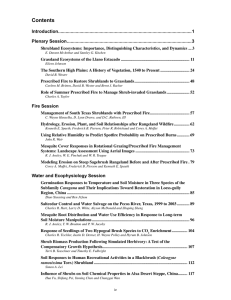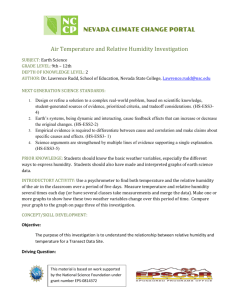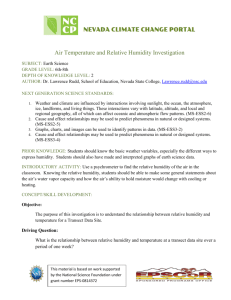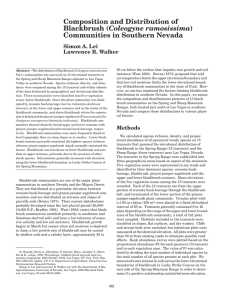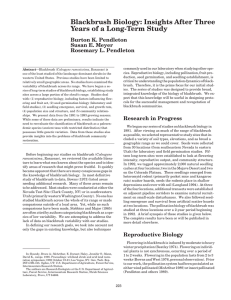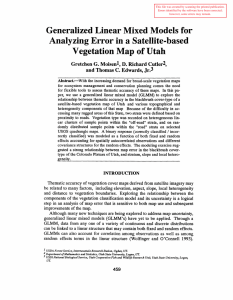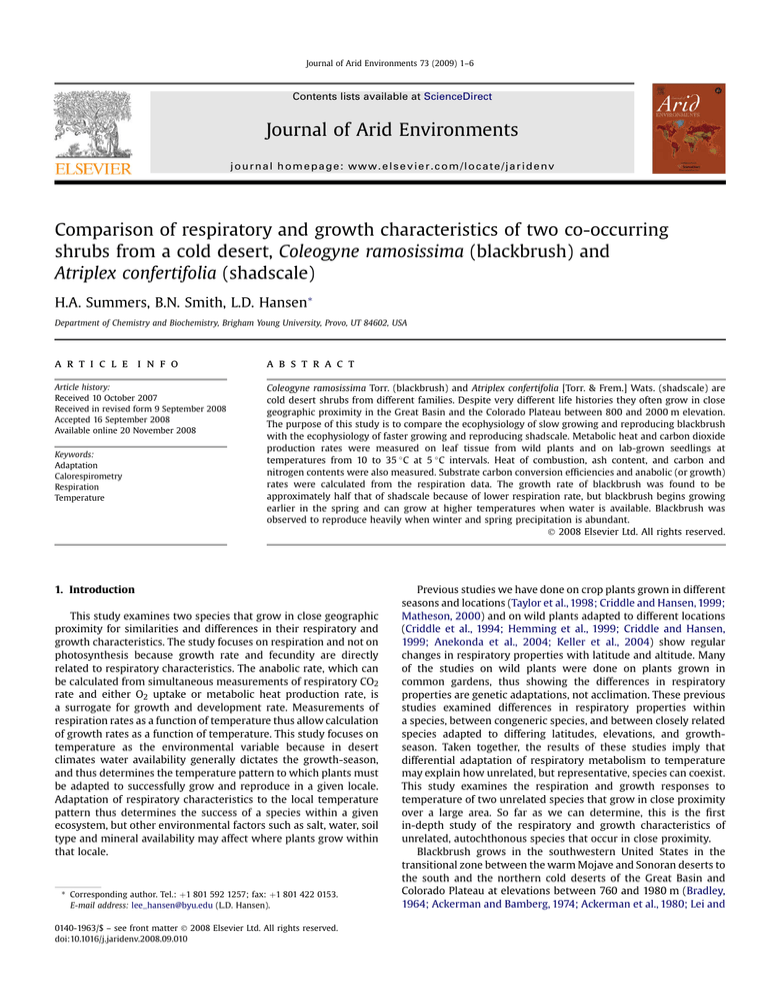
Journal of Arid Environments 73 (2009) 1–6
Contents lists available at ScienceDirect
Journal of Arid Environments
journal homepage: www.elsevier.com/locate/jaridenv
Comparison of respiratory and growth characteristics of two co-occurring
shrubs from a cold desert, Coleogyne ramosissima (blackbrush) and
Atriplex confertifolia (shadscale)
H.A. Summers, B.N. Smith, L.D. Hansen*
Department of Chemistry and Biochemistry, Brigham Young University, Provo, UT 84602, USA
a r t i c l e i n f o
a b s t r a c t
Article history:
Received 10 October 2007
Received in revised form 9 September 2008
Accepted 16 September 2008
Available online 20 November 2008
Coleogyne ramosissima Torr. (blackbrush) and Atriplex confertifolia [Torr. & Frem.] Wats. (shadscale) are
cold desert shrubs from different families. Despite very different life histories they often grow in close
geographic proximity in the Great Basin and the Colorado Plateau between 800 and 2000 m elevation.
The purpose of this study is to compare the ecophysiology of slow growing and reproducing blackbrush
with the ecophysiology of faster growing and reproducing shadscale. Metabolic heat and carbon dioxide
production rates were measured on leaf tissue from wild plants and on lab-grown seedlings at
temperatures from 10 to 35 C at 5 C intervals. Heat of combustion, ash content, and carbon and
nitrogen contents were also measured. Substrate carbon conversion efficiencies and anabolic (or growth)
rates were calculated from the respiration data. The growth rate of blackbrush was found to be
approximately half that of shadscale because of lower respiration rate, but blackbrush begins growing
earlier in the spring and can grow at higher temperatures when water is available. Blackbrush was
observed to reproduce heavily when winter and spring precipitation is abundant.
Ó 2008 Elsevier Ltd. All rights reserved.
Keywords:
Adaptation
Calorespirometry
Respiration
Temperature
1. Introduction
This study examines two species that grow in close geographic
proximity for similarities and differences in their respiratory and
growth characteristics. The study focuses on respiration and not on
photosynthesis because growth rate and fecundity are directly
related to respiratory characteristics. The anabolic rate, which can
be calculated from simultaneous measurements of respiratory CO2
rate and either O2 uptake or metabolic heat production rate, is
a surrogate for growth and development rate. Measurements of
respiration rates as a function of temperature thus allow calculation
of growth rates as a function of temperature. This study focuses on
temperature as the environmental variable because in desert
climates water availability generally dictates the growth-season,
and thus determines the temperature pattern to which plants must
be adapted to successfully grow and reproduce in a given locale.
Adaptation of respiratory characteristics to the local temperature
pattern thus determines the success of a species within a given
ecosystem, but other environmental factors such as salt, water, soil
type and mineral availability may affect where plants grow within
that locale.
* Corresponding author. Tel.: þ1 801 592 1257; fax: þ1 801 422 0153.
E-mail address: lee_hansen@byu.edu (L.D. Hansen).
0140-1963/$ – see front matter Ó 2008 Elsevier Ltd. All rights reserved.
doi:10.1016/j.jaridenv.2008.09.010
Previous studies we have done on crop plants grown in different
seasons and locations (Taylor et al., 1998; Criddle and Hansen, 1999;
Matheson, 2000) and on wild plants adapted to different locations
(Criddle et al., 1994; Hemming et al., 1999; Criddle and Hansen,
1999; Anekonda et al., 2004; Keller et al., 2004) show regular
changes in respiratory properties with latitude and altitude. Many
of the studies on wild plants were done on plants grown in
common gardens, thus showing the differences in respiratory
properties are genetic adaptations, not acclimation. These previous
studies examined differences in respiratory properties within
a species, between congeneric species, and between closely related
species adapted to differing latitudes, elevations, and growthseason. Taken together, the results of these studies imply that
differential adaptation of respiratory metabolism to temperature
may explain how unrelated, but representative, species can coexist.
This study examines the respiration and growth responses to
temperature of two unrelated species that grow in close proximity
over a large area. So far as we can determine, this is the first
in-depth study of the respiratory and growth characteristics of
unrelated, autochthonous species that occur in close proximity.
Blackbrush grows in the southwestern United States in the
transitional zone between the warm Mojave and Sonoran deserts to
the south and the northern cold deserts of the Great Basin and
Colorado Plateau at elevations between 760 and 1980 m (Bradley,
1964; Ackerman and Bamberg, 1974; Ackerman et al., 1980; Lei and
2
H.A. Summers et al. / Journal of Arid Environments 73 (2009) 1–6
Walker, 1997; Pendleton and Meyer, 2004). Shadscale does well in
alkaline and saline soils, allowing growth at lower elevations than
blackbrush, and is found from Canada to Mexico (Ackerman and
Bamberg, 1974; Ackerman et al., 1980). While the ranges of blackbrush and shadscale overlap and the species are often found
growing in close proximity, they occupy different niches defined by
soil type. Blackbrush is almost completely confined to shallow,
coarse-textured soils, while shadscale is a specialist on deep, fine
textured soils. Blackbrush is not found on soils with excess solutes,
whereas shadscale, while not found on highly saline sites, is often
found on soils that contain moderate levels of solutes. The two
species are thus not competitors, but where they grow in close
proximity, must be adapted to the same patterns of temperature
and water.
There are significant differences in the biology, life histories, and
phylogenies of Blackbrush (Coleogyne ramosissima Torr.), which is
a shrub in Rosaceae, and of shadscale (Atriplex confertifolia [Torr. &
Frem.] Wats.) which is a shrub in Chenopodiaceae. The mechanisms
of adaptation of the two species are exceedingly different. Blackbrush is very slow growing and very long-lived, some individuals
reaching 400 years of age (Callison and Brotherson, 1985). In good
years, blackbrush produces perfect flowers for two to three weeks
from late March to early May but only when winter and spring
precipitation is abundant. Blackbrush exists only as a diploid with
a chromosome count of 2n ¼ 16 (McArthur and Sanderson, 1985).
Blackbrush is an ecotonal species and can be upset by frequent
large fires, road building and mining, and invasion by exotic species
(Callison et al., 1985; Pendleton et al., 1995). Stebbins and Major
(1965) described it as a paleoendemic species with little variation,
perhaps on its way to extinction. However, paleoecological
evidence indicates that blackbrush has a sufficient gene pool to
have evolved different ranges of tolerance (Wells, 1983) and to have
successfully migrated along environmental gradients in response to
climatic changes (Phillips and Van Devender, 1974; Spaulding,
1990). Populations of blackbrush also show differences in plant size
and germination characteristics (Pendleton et al., 1995). In shadscale, male and female flowers appear annually in the spring on
separate plants (Welsh et al., 1987). The species consists of five
ploidy races from diploid to decaploid. Shadscale plants of different
ploidy races are autoploid (Stutz and Sanderson, 1983) and
ecological differences exist among the races (Stutz and Sanderson,
1983; Sanderson et al., 1989), indicating rapid adaptation to new, or
changed, environments (Sanderson et al., 1990). Thus, blackbrush
apparently is adapted for a slow growth strategy for long-term
survival in an environment with little fluctuation of resources and
few rewards for rapid growth or a plastic growth response. On the
other hand, shadscale grows faster, reaches reproductive maturity
quickly, and produces long-lived seeds, a strategy that makes it
drought prone and short-lived relative to blackbrush, but successful
at the population level.
2. Materials and methods
The objective of this research is to measure respiration rates,
and from those data, calculate respiration efficiency and growth
rates as functions of temperature, and then to compare these
characteristics for blackbrush and shadscale. Metabolic and growth
responses to environmental temperatures can be determined by
calorespirometric measurements of metabolic heat and CO2 rates
(Criddle et al., 1997, Criddle and Hansen, 1999; Smith et al., 1999;
Hansen et al., 2004, 2005). Catabolism and anabolism can be
separately characterized by this method (Hansen et al., 2002,
2004). The rate of respiration multiplied by the efficiency (i.e. the
ratio of anabolic rate to total respiration rate) equals the anabolic or
growth rate; therefore determination of respiration rate and efficiency as functions of temperature can be used to demonstrate
adaptation of growth rate to environmental temperatures at
a particular locale (Hansen et al., 2002).
Seeds were gathered from different populations of blackbrush
(Appendix 1, electronic version only), germinated at 15 C after
a pre-chill treatment (Pendleton and Meyer, 2004), and grown in
a growth chamber at 25 C. Leaf tissue was also collected from
established wild populations near Moab, Utah (Appendix 1, electronic version only); branches were cut from 2 to 6 representative
plants, placed in a plastic bag in a cooler with ice, transported to the
lab and placed in a 5 C refrigerator until the measurements were
made, usually within 48 h of harvest. Although seeds were gathered from different populations of shadscale, germinated, and
planted in a greenhouse, the seedlings all died from fungal infection. Thus, shadscale data are for leaf tissue collected in the same
way as above from established populations (Appendix 1, electronic
version only) in the wild only. Where possible, shadscale accessions
of different ploidy levels were also compared.
Young, growing leaves were cut from the branches with a razor
blade and about 100 mg fresh weight placed in an ampule of an
isothermal calorimeter (Hart Scientific Model 7707 or Calorimetry
Sciences Corporation Model 4100) and the heat rate (Rq) and the
rate of CO2 production (RCO2 ) measured by the methods described
in Criddle et al. (1997), Criddle and Hansen (1999), and Hansen et al.
(2005). These measurements were repeated on a given sample at
temperatures ranging either downward from 20 to 10 C or upward
from 20 to 35 C in five-degree increments. Replicates of tissue
samples were sometimes limited by the amount of young tissue
available, but were run as often as possible and range from two to
six. Dry weights were obtained after samples were dried in
a vacuum oven at 70–80 C for at least 24 h. Appendix 2 (electronic
version only) gives representative Rq and RCO2 data. The dried
samples from metabolic measurement were used to determine
heats of combustion with a model 1425 Parr oxygen bomb calorimeter calibrated with benzoic acid. Samples were ground and
combined to give 0.2 g samples for each combustion; four to ten
replicates were run. Ash content was determined as the mass
remaining in the combustion boat. Carbon and nitrogen contents
were determined on the combined material with an elemental
analyzer (Costech, Model ECS 4010); five replicates were run.
Predicted growth rate is calculated as
RSG DHB ¼ ð1 gs =4ÞDHO2 RCO2 Rq
(1)
where RSG is the specific anabolic (or growth) rate, and DHB is the
enthalpy change for the reaction
Csub þ ðN; P; K; etc:Þ/Cbio þxO2
(2)
which can be estimated from the difference in the heats of
combustion per C-mole of biomass (Cbio) and photosynthate (Csub)
(Hansen et al., 2002; Ellingson et al., 2003). gs is the oxidation
number of carbon in the respiratory substrate, and DHO2 is Thornton’s constant (Thornton, 1917), in general 455 15 kJ mol1 O2,
or more exactly, the heat of combustion of the substrate per mole of
O2. Eq. (1) shows that growth can occur only at those temperatures
where ð1 gs =4ÞDHO2 RCO2 exceeds Rq (Criddle et al., 1997).
(1 gs/4) is the conversion factor between RCO2 and Rq that
depends on substrate carbon oxidation state. In this study the
substrate is assumed to be carbohydrate, with gs ¼ 0 and
DHO2 ¼ 470 kJ mol1 O2 , yielding 470RCO2 in mW mg1 dw for
the first term in Eq. (1). An example of RSGDHB data is shown in
Appendix 2 (electronic version only). Several previous studies
(Criddle et al., 1997; Criddle and Hansen, 1999; Ellingson et al.,
2003) show that RSGDHB is directly proportional to the relative
growth rate of young vegetative tissues measured by traditional
methods.
H.A. Summers et al. / Journal of Arid Environments 73 (2009) 1–6
The calorespirometric ratio Rq =RCO2 is a measure of efficiency for
growth driven by aerobic respiration. Eq. (3)
(3)
shows how the calorespirometric ratio is related to e, the substrate
carbon conversion efficiency (Hansen et al., 2002). In aerobic
systems with carbohydrate substrate, decreases in Rq =RCO2 indicate
a decrease in the catabolic/anabolic ratio, and hence an increasing
efficiency for producing anabolic products. An example of Rq =RCO2
data is shown in Appendix 2 (electronic version only).
3. Results
Coleogyne ramosissima
0.020
RCO2 / nmol s-1 mg-1
Rq =RCO2 ¼ ð1 gs =4ÞDHO2 DHB ½3=ð1 3Þ
0.015
0.010
Island
Winchester
Beaver
Kyle
Rockies
0.005
0.000
0
Composition and heat of combustion data are given in Appendix
3 (electronic version only). Carbon content is higher in blackbrush
than in shadscale because of the lower ash content in blackbrush.
Ash content of shadscale is 4–5 times higher than that of blackbrush. Nitrogen content of shadscale is twice that of blackbrush;
the N/C mass ratios are 0.081 0.012 and 0.041 0.002 for shadscale and blackbrush, respectively where the uncertainty is the
standard error of the mean. Heats of combustion per C-mole of
blackbrush (497 9 kJ Cmol1) and shadscale (492 9 kJ Cmol1)
are within the standard of error in the data, indicating there is no
difference between the species, and therefore an average carbon
oxidation number, gB ¼ 0.21 0.07 and DHB ¼ þ25 9 kJ Cmol1
for both species. None of the variables in Appendix 3 (electronic
version only) correlate with ploidy of shadscale.
Figs. 1 and 2 show the rate of CO2 production plotted against
metabolic heat rate for all the individual data points for shadscale
and blackbrush, respectively. The scatter around the least squares
line is largely due to variation in the ratio RCO2 =Rq with measurement temperature. The average substrate carbon conversion efficiencies, calculated from the least squares slopes with zero
intercept, (70 7)% and (74 5)% for blackbrush and shadscale,
respectively, do not differ significantly as shown by the standard
deviation. However, the maximum rates for blackbrush are less
than half those of shadscale (note the difference in scale in Figs. 1
and 2). This lower respiration rate is the primary reason that
blackbrush grows more slowly than shadscale. There is no apparent
effect of seed source on the respiratory properties of blackbrush in
Fig. 2. However, for shadscale, although ploidy appears to have little
or no effect on the metabolic efficiency (i.e. the slope in Fig. 1), the
2
4
6
8
10
Rq /μW mg-1
Fig. 2. Rate of CO2 evolution (RCO2 ) against metabolic heat rate (Rq) for leaf tissue from
blackbrush seedlings grown from seed collected from different locations as indicated
by different symbols. The lower, gray line represents the heat of combustion of
carbohydrate, y ¼ (1/470)x, and the upper, solid line is the least squares fit to the data
with a forced zero intercept, y ¼ (0.00242 0.00015)x, r2 ¼ 0.977. Measurement
temperature ranges from 10 to 35 C.
respiratory heat and CO2 production rates decrease and thus
growth rates decrease as ploidy increases. Appendix 4 (electronic
version only) shows anabolic rates (RSGDHB) within shadscale
populations at a given location decrease systematically with
increasing ploidy. However, quantitation of the effect of ploidy is
not possible from these data because tissue samples were collected
from the different populations at different times in the season.
Since the metabolic rates change with time of season (see Fig. 3),
anabolic rates cannot be compared between populations. Fig. 4
shows that blackbrush tissue collected from wild plants shows
a similar change in metabolic rate with time of season.
For shadscale tissue collected in Moab from late April through
early June, the highest anabolic rate (RSGDHB) occurs in May and the
lowest in June (Fig. 3). The difference in these rates between May
and June is quite marked, with rates in June about half those in May.
Although the optimum temperature (25–30 C) changes little
through the season, RSGDHB suddenly drops off at 35 C for tissue
collected in April but not tissue collected later in the season, indicating increasing tolerance for higher temperatures as the season
progresses.
Blackbrush leaf tissue collected from Moab showed a shift in the
optimum temperature for growth (RSGDHB) over the three-month
period (Fig. 4). In March, optimum growth occurred between 25
Atriplex confertifolia
0.05
1.6
0.04
RSGΔHB/ μW mg-1
RCO2 / nmol s-1 mg-1
0.06
3
0.03
2x
4x
6x
8x
10x
0.02
0.01
1.2
4/24/04
5/11/04
6/3/04
0.8
0.4
0.00
0
5
10
15
20
25
Rq / μW mg-1
Fig. 1. Rate of CO2 evolution (RCO2 ) plotted against metabolic heat rate (Rq) for leaf
tissue from the different ploidy races of shadscale as indicated by different symbols.
The lower, gray line represents the heat of combustion of carbohydrate, y ¼ (1/470)x,
and the upper, solid line is the least squares fit to the data with a forced zero intercept,
y ¼ (0.00251 0.00019)x, r2 ¼ 0.962. Measurement temperature ranges from 10 to
35 C.
0.0
10
20
30
Temperature / °C
Fig. 3. Specific growth rate (RSGDHB) as a function of temperature, calculated from
metabolic heat and CO2 rates, in microwatts (mW) per mg dry weight for shadscale leaf
tissue collected from Moab in late April to early June. The bars indicate the standard
error [SE ¼ O(MSE 2/r)] that applies to data points at each temperature.
4
H.A. Summers et al. / Journal of Arid Environments 73 (2009) 1–6
A
0.8
440
420
3/9/04
4/24/04
5/11/04
6/3/04
1.2
Rq/RCO2 / kJ mol-1
RSGΔHB/ mW mg-1
1.6
0.4
400
380
lower elevation
higher elevation
360
0.0
10
20
30
340
Temperature / °C
10
and 30 C and by May shifted to 35 C, apparently in response to
rising average temperatures. In blackbrush, the highest anabolic
rates were in tissue collected in May, while leaf tissue collected in
April showed rates almost as low as leaf tissue collected in June
(Fig. 4). The anomalously high rates measured in March compared
with April probably relate to flowering, which occurred from midApril to mid-May. Floral tissue (buds and young flowers) collected
in April had a much higher RSGDHB than did leaf tissue collected at
the same time (Fig. 5) indicating that during early flowering the
plants’ resources were diverted from leaf growth to reproduction.
More detailed examination of the data in Figs. 1 and 2 shows the
temperature response of metabolism differs with the elevation of
the seed source for blackbrush and of the wild shadscale plants
sampled. Fig. 6A shows the averaged calorespirometric ratio
(Rq =RCO2 ) for blackbrush tissue grown from seed from populations
at higher elevations (Island in the Sky, 1866 m; Little Rockies,
1646 m; and Beaver Dam summit, 1450 m) and at lower elevations
(Kyle Canyon, 1280 m; Winchester Hills, 1189 m). Blackbrush
seedlings grown from seed from higher elevations had minimum
Rq =RCO2 near 20 C, while blackbrush from lower elevations had the
minimum near 25 C. Note that a lower Rq =RCO2 ratio indicates
a higher efficiency, see Eq. (3). Fig. 6B shows that the Rq =RCO2 ratio
for shadscale responds similarly to temperature and elevation. The
3.0
leaf tissue
floral tissue
RSGΔHB/ mW mg-1
2.5
2.0
1.5
1.0
0.5
0.0
10
20
30
Temperature / °C
Fig. 5. Specific growth rate RSGDHB as a function of temperature, calculated from
metabolic heat and CO2 rates, in microwatts (mW) per mg dry weight for blackbrush
floral and leaf tissue collected 4/24/2004 from Moab. The bars indicate the standard
error [SE ¼ O(MSE 2/r)] that applies to data points at each temperature.
B
30
420
400
Rq/RCO2 / kJ mol-1
Fig. 4. Specific growth rate (RSGDHB) as a function of temperature, calculated from
metabolic heat and CO2 rates, in microwatts (mW) per mg dry weight for blackbrush
leaf tissue collected from Moab 3/9/2004 (not in flower), 4/24/2004 (flowering), 5/11/
2004 (near end of flowering), and 6/3/2004 (past floweringdin fruit). The bars indicate
the standard error [SE ¼ O(MSE 2/r)] that applies to data points at each temperature.
20
Temperature / °C
380
360
lower elevation
higher elevation
340
320
300
10
20
30
Temperature / °C
Fig. 6. Rq =RCO2 values as a function of temperature [A] for blackbrush seedlings
grown from seed from lower elevations (Winchester Hills, and Kyle Canyon) and
higher elevations (Island in the Sky, Little Rockies, Beaver Dam, Veyo Road, and South
of Bluff), and [B] for shadscale leaf tissue from wild plants from lower (Lake Mead
and Moab) and higher (Millard, Smokey Mtn, Smokey Hollow, Rush Valley, Four
Corners, Bigwater, and Cliff Dwellers) elevations. The bars indicate the standard error
[SE ¼ O(MSE 2/r)] that applies to data points at each temperature. Note that the
error bars for shadscale include the scatter caused by sampling plants at different
times in the season. The significant point to note is the shape of the curve is not
affected by this source of scatter.
values of the Rq =RCO2 ratio and the associated uncertainties shown
in Fig. 6 show that at the optimum temperature, blackbrush
respiration may be slightly less efficient (78 1%) than shadscale
(82 1%) (p < 0.05). At 10 C, the differences in substrate carbon
conversion efficiency between the species, i.e. 3 ¼ 69 7% for
blackbrush and 74 5% for shadscale, are within the standard error.
At 35 C shadscale may be slightly more efficient than blackbrush,
i.e. 3 ¼ 62 2% for blackbrush and 69 2% for shadscale (p < 0.1).
Because the blackbrush was grown in a common environment, the
source of the variation with temperature in this species must be
genetic adaptation, not acclimation. The response of this characteristic of respiration to temperature is remarkably consistent
between the species.
The figure in Appendix 5 (electronic version only) shows typical
examples of Arrhenius plots (i.e. plots of ln(rate) versus reciprocal
Kelvin temperature, ln(rate) ¼ (ln A) þ (mrate/T) where A and m are
constants) of RCO2 and Rq for blackbrush and shadscale. (For reference, m ¼ 6 corresponds to Q10 ¼ 2.) The plots for shadscale are
linear from 10 to 25 C above which the plots are curved with
decreasing slope. Plots for blackbrush show an abrupt decrease in
slope between 20 and 25 C, but appear to be linear from 10 to
20 C and from 25 to 35 C. Above 35 C the plots are curved with
decreasing slope. Appendix 1 (electronic version only) gives the
H.A. Summers et al. / Journal of Arid Environments 73 (2009) 1–6
11
9
μq/kK
7
5
Blackbrush(10-20°C)
Shadscale(10-25°C)
Blackbrush(25-30°C)
3
1
1
3
5
7
9
11
μCO2/kK
Fig. 7. Correlation between the Arrhenius temperature coefficients for metabolic heat
rate (Rq) and CO2 production rate (RCO2 ), see Appendix 1.
Arrhenius temperature coefficients (mq and mCO2 ) for all the populations. In the lower temperature range, the m values are clustered
around 9 k K1, corresponding to Q10 ¼ 3. The m values clustered
around 3 kK1 in the upper temperature range correspond to
Q10 ¼ 1.4. The values of mq and mCO2 are strongly correlated
(r2 ¼ 0.961) as shown in Fig. 7, demonstrating that the catabolic rate
(Rq) and the sum of the anabolic and catabolic rates (RCO2 ) have
similar temperature dependencies. In the lower temperature range,
mCO2 > mq , as required for a growth rate that increases with
increasing temperature. In the upper temperature range, mCO2 < mq ,
as required for a growth rate that decreases with increasing
temperature. The curves of Rq =RCO2 versus temperature in Fig. 6 are
a further reflection of the differing temperature dependencies of Rq
and RCO2 . The temperature dependence of the growth rate is thus
determined by both the temperature dependence of the metabolic
rate and the temperature dependence of the efficiency, (see Fig. 6).
As indicated by the different temperatures of the minima in Fig. 6A
and B, the temperature of maximum efficiency and growth rate is
expected to decrease with increasing elevation and latitude,
requiring concomitant regular changes in m values. However, in this
study there are too few data points, and not favorably distributed,
to determine the correlation between m and latitude and elevation,
but the results do not disagree with the correlation found in a more
extensive previous study of three other desert shrub species
(Criddle et al., 1994). The previous study examined only the
correlation with mq, but Fig. 7 shows a similar correlation would
hold for mCO2 .
4. Discussion
The data in Appendix 4 (electronic version only), showing
decreasing RSGDHB with increasing ploidy, agree with previous
observations on growth of shadscale. Shadscale plants with higher
ploidy numbers are generally smaller, particularly than diploid
plants (Stutz and Sanderson, 1983). The increase in ploidy
(2–10) appears to be the mechanism for physiological adaptation of shadscale to new habitats. Diploid shadscale is found above
the level of the Pleistocene lakes, while polyploids grow in valley
sides and bottoms. These polyploids probably formed as the lakes
disappeared and new habitats appeared (Stutz and Sanderson,
1983). In general, available moisture decreases and salinity
increases with decreasing elevation in the shadscale range.
Increased ploidy is also correlated with increased osmotic capability (Sanderson et al., 1989), corresponding to increasing salinity
from foothills to valley bottom. The large ash content of shadscale
leaves reflects the halophilous character of this species.
5
As a surrogate for environmental temperature, elevation has
a clear effect on the temperature of maximum substrate
conversion efficiency (p 0.01) (Fig. 6) and therefore also on the
temperature of maximum growth rate of both blackbrush and
shadscale. Blackbrush seed germination requirements also vary
with elevation; populations from lower (warmer) elevations
have lower primary seed dormancy and shorter chilling
requirements than populations from higher elevations (Lei, 1997;
Pendleton and Meyer, 2004). Thus, while blackbrush has
commonly been assumed to be a paleoendemic species lacking
in genetic variation (following the original postulation by Stebbins and Major, 1965), there clearly is genetic variation among
blackbrush populations.
Shadscale and blackbrush tissue collected in Moab showed the
highest specific anabolic rates in May (Figs. 3 and 4), indicating that
they have both adapted to their environment so they grow most
when average temperatures are warmer, but when water is still
available. In agreement with the hypothesis that adaptation to
grow in a common environmental temperature pattern requires
similar respiratory responses to temperature, their responses to
temperature and elevation are very similar. These similarities in
responses of growth and respiration to temperature clearly exist
despite large differences in life histories and non-respiratory
characteristics. Some quantitative differences in respiratory properties other than temperature responses are present. The most
notable differences are that, at optimum growth temperatures and
time of season when growth rate is maximum, specific anabolic
rates of shadscale are approximately double those of blackbrush.
Although the temperature responses of growth and respiration
rates in the two species are very similar during the spring and early
summer, in mid- to late-summer the temperature responses of Rq
and of RCO2 differ. Blackbrush acclimates to higher temperatures
earlier in the season than does shadscale, and once it has adjusted
to higher temperatures, anabolic rates keep rising with increasing
temperatures, even in June (Fig. 5), while for shadscale, anabolic
rates flatten out or even drop off slightly between 25 and 30 C
(Fig. 3). Blackbrush should therefore be able to carry out anabolic
activity in Moab even in the heat of summer as long as there is
sufficient water. In agreement with this, blackbrush, unlike many
other desert shrubs, has been shown to be able to utilize rare
summer rainfall events efficiently (Lin et al., 1996; Gebauer and
Ehleringer, 2000). Metabolic adaptation of blackbrush for slow
growth and growth at high temperatures so as to take advantage of
summer rain appears to result from natural selection for long-term
survival in an environment where resources (e.g. nitrogen and
water) are scarce, but relatively stable over the long-term. In
comparison, shadscale metabolism is adapted for fast growth and
early reproduction in the more variable environment of deep, fine
textured soils with a high salt content. These two very different
strategies are apparent in the metabolic characteristics and
apparently confine these species to their niches as defined by soil
type.
Acknowledgments
This research was supported in part by funds provided by the
Rocky Mountain Research Station, Forest Service, U.S. Department
of Agriculture and Brigham Young University. Our thanks to Dr.
Burton Pendleton and Dr. Stewart Sanderson for collecting seed and
vegetative tissue from many locations.
Appendix 1. Supplementary data
Supplementary data associated with this article can be found, in
the online version, at doi:10.1016/j.jaridenv.2008.09.010.
6
H.A. Summers et al. / Journal of Arid Environments 73 (2009) 1–6
References
Ackerman, T.L., Bamberg, S.A., 1974. Phenological studies in the Mojave Desert at
rock valley (Nevada Test Site). In: Lieth, H. (Ed.), Phenology and Seasonality
Modeling. Springer-Verlag, New York, pp. 215–226.
Ackerman, T.L., Romney, E.M., Wallace, A., Kinnear, J.E., 1980. Phenology of desert
shrubs in southern Nye County, Nevada. In: Nevada Desert Shrub Ecology. The
Great Basin Naturalist Memoirs, vol. 4. Brigham Young University, Provo, UT, pp.
4–23.
Anekonda, T., Jones, C., Smith, B.N., Hansen, L.D., 2004. Differences in physiology
and growth between coastal and inland varieties of Douglas fir seedlings in
a common garden. Thermochimica Acta 422, 75–79.
Bradley, W.G., 1964. The vegetation of the Desert game range with special reference
to the Desert Bighorn. Transactions, Desert Bighorn Council, 43–67.
Callison, J., Brotherson, J.D., 1985. Habitat relationships of the blackbrush community (Coleogyne ramosissima) of southwestern Utah. Great Basin Naturalist 45,
321–326.
Callison, J., Brotherson, J.D., Bowns, J.E., 1985. The effects of fire on the blackbrush
[Coleogyne ramosissima] community of southwestern Utah. Journal of Range
Management 38, 535–538.
Criddle, R.S., Hopkin, M.S., McArthur, E.D., Hansen, L.D., 1994. Plant distribution and
the temperature coefficient of metabolism. Plant, Cell and Environment 17,
233–243.
Criddle, R.S., Smith, B.N., Hansen, L.D., 1997. A respiration based description of plant
growth rate responses to temperature. Planta 201, 441–445.
Criddle, R.S., Hansen, L.D., 1999. Calorimetric methods for analysis of plant
metabolism. In: Kemp, R.B. (Ed.), Handbook of Thermal Analysis and Calorimetry. Elsevier, Amsterdam, pp. 711–763.
Ellingson, D., Olson, A., Matheson, S., Criddle, R.S., Smith, B.N., Hansen, L.D., 2003.
Determination of the enthalpy change for anabolism by four methods. Thermochimical Acta 400, 79–85.
Gebauer, R.L.E., Ehleringer, J.R., 2000. Water and nitrogen uptake patterns following
moisture pulses in a cold desert community. Ecology 81, 1415–1424.
Hansen, L.D., Church, J.N., Matheson, S., McCarlie, V.W., Thygerson, T., Criddle, R.S.,
Smith, B.N., 2002. Kinetics of plant growth and metabolism. Thermochimica
Acta 388, 418–425.
Hansen, L.D., Macfarlane, C., Mckinnon, N., Smith, B.N., Criddle, R.S., 2004. Use of
calorespirometric ratios, heat per CO2 and heat per O2, to quantify metabolic
paths and energetics of growing cells. Thermochimica Acta 422, 55–61.
Hansen, L.D., Criddle, R.S., Smith, B.N., 2005. Calorespirometry in plant biology. In:
Lambers, H., Ribas-Carbon, M. (Eds.), Plant Respiration, from Cell to Ecosystem.
Springer, Dordrecht, pp. 17–30.
Hemming, D.J.B., Meyer, S.E., Smith, B.N., Hansen, L.D., 1999. Respiration characteristics differ among cheatgrass (Bromus tectorum L.) populations. Great Basin
Naturalist 59, 355–360.
Keller, E.A., Anekonda, T.S., Smith, B.N., Hansen, L.D., St. Clair, J.B., Criddle, R.S., 2004.
Stress and respiration traits differ among four geographically distinct Pinus
ponderosa seed sources. Thermochimica Acta 422, 69–74.
Lei, S.A., 1997. Variation in germination response to temperature and water availability in blackbrush (Coleogyne ramosissima) and its ecological significance.
Great Basin Naturalist 57, 172–177.
Lei, S.A., Walker, L.R., 1997. Biotic and abiotic factors influencing the distribution
of Coleogyne communities in southern Nevada. Great Basin Naturalist 57,
163–171.
Lin, G., Phillips, S.L., Ehleringer, J.R., 1996. Monsoonal precipitation responses of
shrubs in a cold desert community on the Colorado Plateau. Oecologia 106, 8–17.
Matheson S., 2000. Metabolic adaptation of oats to climatic temperature. Thesis,
Brigham Young University, Provo, UT, USA.
McArthur, E.D., Sanderson, S.C., 1985. A cytotaxonomic contribution to the western
North American Rosaceous flora. Madroño 32, 24–28.
Pendleton, B.K., Meyer, S.E., 2004. Habitat-correlated variation in blackbrush
(Coleogyne ramosissima: Rosaceae) seed germination response. Journal of Arid
Environments 59, 229–243.
Pendleton, B.K., Meyer, S.E., Pendleton, R.L., 1995. Blackbrush biology: insights after
three years of a long-term study. In: Roundy, B.R., McArthur, E.D., Haley, J.S.,
Mann, D.K. (Eds.), Wildland Shrub and Arid Land Restoration Symposium.
Proceedings INT-GTR-315. Ogden, UT. USDA Forest Service, Intermountain
Research Station, Provo, UT, pp. 223–227.
Phillips III, A.M., VanDevender, T.R., 1974. Pleistocene packrat middens from the
lower Grand Canyon of Arizona. Journal of the Arizona Academy of Science 9,
117–119.
Sanderson, S.C., McArthur, E.D., Stutz, H.C., 1989. A relationship between polyploidy
and habitat in western shrub species. In: Wallace, A., McArthur, E.D.,
Haferkamp, M.R. (Eds.), Symposium on Shrub Ecophysiology and Biotechnology.
Proceedings INT-256. Ogden, UT. USDA Forest Service, Intermountain Research
Station, Provo, UT, pp. 23–30.
Sanderson, S.C., Stutz, H.C., McArthur, E.D., 1990. Geographic differentiation in
Atriplex confertifolia. American Journal of Botany 77, 490–498.
Smith, B.N., Jones, A.R., Hansen, L.D., Criddle, R.S., 1999. Growth, respiration rate,
and efficiency responses to temperature. In: Pessarakli, M. (Ed.), Handbook of
Plant and Crop Stress, second ed. Marcel Dekker, Inc., New York, pp. 417–440.
Spaulding, W.G., 1990. Vegetation dynamics during the last deglaciation, southeastern Great Basin. U.S.A. Quaternary Research 33, 118–203.
Stebbins, G.L., Major, J., 1965. Endemism and speciation in the California flora.
Ecological Monographs 35, 1–35.
Stutz, H.C., Sanderson, S.C., 1983. Evolutionary studies of Atriplex: chromosome
races of A. confertifolia (shadscale). American Journal of Botany 70, 1536–1547.
Taylor, D.K., Rank, D.R., Keiser, D.R., Smith, B.N., Criddle, R.S., Hansen, L.D., 1998.
Modelling temperature effects on growth-respiration relations of maize. Plant,
Cell and Environment 21, 1143–1151.
Thornton, W.M., 1917. The relation of oxygen to the heat of combustion of organic
compounds. Philosophical Magazine 33, 196–203.
Wells, P.V., 1983. Paleobiogeography of montane islands in the Great Basin since the
last glaciopluvial. Ecological Monographs 53, 341–382.
Welsh, S.L., Atwood, N.D., Goodrich, S., Higgins, L.C., 1987. A Utah Flora. In: Great
Basin Naturalist Memoirs, vol. 9. Brigham Young University, Provo, UT, p. 118.


